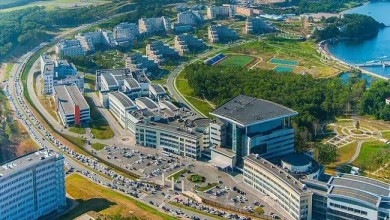London Travel Chaos Sees New Disruption Hits Victoria Station – Commuters Struggle Amid Escalator Failure!

Published on
November 6, 2025
On the morning of November 6, 2025, commuters in London faced significant disruptions as Victoria station was unexpectedly closed due to a malfunctioning escalator. The station, a major hub for both commuters and tourists, was rendered temporarily inoperable as engineers worked to resolve the issue. While the closure caused confusion and delays during the morning rush hour, services on the Victoria, Circle, and District Lines remained largely unaffected, providing some relief for passengers navigating through the busy transport network.
Despite the escalator failure, which led to the immediate closure of the station, Transport for London (TfL) issued updates, reassuring the public that other lines would continue to operate as scheduled. However, this incident highlighted how even minor disruptions at key stations can ripple throughout the transport network, leading to wider delays and frustrations.
How the Disruption Unfolded
The issue began early in the morning when a malfunction was detected on the escalator system at Victoria station. As part of standard safety procedures, the decision was made to shut down the station while repairs were initiated. This decision created a bottleneck for many commuters who rely on the station to connect to other parts of London and the broader transport network.
Though the Victoria station was closed, the disruption did not extend to the Victoria, Circle, or District Lines, as these services continued to run without major incidents. However, the closure did have a knock-on effect, leading to delays and congestion at other stations within the area. Many passengers were forced to find alternative routes to their destinations, leading to longer commutes and increased pressure on other parts of the London Underground system.
Key Impact Areas of the Disruption
Victoria Line, Circle Line, and District Line
The Victoria Line, which is often used by commuters traveling to central London, was not directly impacted by the closure of Victoria station. Similarly, services on the Circle Line and the District Line were able to maintain their regular schedules. However, commuters using these lines faced an indirect impact due to increased crowding at neighboring stations.
Although the disruption did not spread to these major lines, the closure of Victoria station meant that many passengers had to find alternative stations to catch connecting services, leading to congestion and longer travel times.
Elizabeth Line
The Elizabeth Line, a major new addition to the London Underground network, was also affected by delays. Initially, severe disruptions were reported along the entire line, with some trains being cancelled or delayed by up to 30 minutes. Passengers traveling through central London were advised to check the status of their trains and allowed to use alternative routes if necessary.
The disruption on the Elizabeth Line was expected to continue throughout the morning until around 1:00 p.m. By this time, many of the services had been restored, although minor delays persisted. Commuters were encouraged to use alternative routes such as c2c services between London Fenchurch Street and Upminster, or Great Western Railway services between London Paddington and Reading.
Greater Anglia and Bakerloo Line
Further disruptions were noted on the Greater Anglia network, with trains being delayed by up to 45 minutes. These delays were expected to last until approximately 11:30 a.m., causing additional strain for passengers traveling out of London. Meanwhile, the Bakerloo Line saw a return to normal services after a brief period of disruption earlier in the day, providing some respite for passengers traveling through the area.
Alternative Routes and Passenger Advice
During the period of disruption, commuters were urged to make use of alternative routes to avoid delays. For those traveling on the Elizabeth Line, TfL advised passengers to use several other train and bus services, including the London Overground, South Western Railway, Southeastern, and Thameslink networks. Additionally, local buses were available to support commuters who needed to get around the affected area.
Many passengers opted to take buses or find alternative routes via the London Underground and National Rail services. These options helped to alleviate some of the pressure at key stations, although the overall travel experience was still impacted by the broader disruption across the city.
Wider Implications of the Disruption
This incident at Victoria station serves as a reminder of the delicate nature of London’s transport network, where even a single technical issue can have a far-reaching impact. The capital’s transport system is one of the busiest and most complex in the world, and disruptions—whether caused by technical faults, strikes, or accidents—can lead to major delays, especially during peak hours.
While Victoria station’s closure was resolved relatively quickly, it illustrated how essential it is to maintain the infrastructure and operational capacity of key transport hubs. As part of the wider effort to improve services and reduce delays, TfL has emphasized the importance of regular maintenance and upgrades to the city’s transport systems.
Commuters’ Frustration and the Path Forward
Commuters expressed frustration at the unexpected disruption, particularly as it coincided with the busy morning rush hour. Many shared their experiences on social media, commenting on the inconvenience caused by the station’s closure. Passengers noted how the lack of timely information led to confusion and delays as they scrambled to find alternative routes.
Despite the efforts to keep services on other lines running smoothly, it was clear that the disruption caused ripple effects across the network, extending far beyond the immediate area surrounding Victoria station. As part of the ongoing efforts to improve passenger experience, TfL is expected to review its response to such incidents and work on better communication strategies to help minimize the impact of future disruptions.





